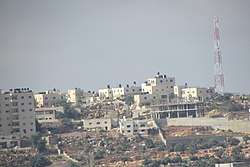Abu Shukheidim
| Abu Shukheidim | |
|---|---|
| Other transcription(s) | |
| • Arabic | ابو شخيدم |
 Northern part of Abu Shukheidim | |
 Abu Shukheidim Location of Abu Shukheidim within Palestine | |
| Coordinates: 31°57′53″N 35°10′25″E / 31.96472°N 35.17361°ECoordinates: 31°57′53″N 35°10′25″E / 31.96472°N 35.17361°E | |
| Palestine grid | 166/152 |
| Governorate | Ramallah & al-Bireh |
| Government | |
| • Type | Municipality |
| • Head of Municipality | Abdullah Ladadwa |
| Area | |
| • Jurisdiction | 15,500 dunams (15.5 km2 or 6.0 sq mi) |
| Population (2013) | |
| • Jurisdiction | 8,105 |
| Name meaning | The father of Shukheidim[1] |
Abu Shukheidim was a Palestinian village in the Ramallah and al-Bireh Governorate.
In 2005 it merged with the village of Al-Mazra'a al-Qibliya to form the town of Al-Zaitounah.
History
Pottery sherds from the Hellenistic/Roman, Byzantine, Crusader/Ayyubid and the Mamluk eras have been found here.[2]
Ottoman era
Sherds from the early Ottoman era has also been found here.[2]
In 1838, it was noted as a Muslim village, Abu Shukheidim, in the Bani Harith district, north of Jerusalem.[3][4]
In 1863 Victor Guérin found it consisting of a dozen houses. A birket (artificial pond) was lined on the inside with good cement, but needed repairs. Near the birket were several very old buildings. The villagers were compelled to stock up on water at a well located at the bottom of the mountain whose village occupies the summit.[5]
An Ottoman village list of about 1870 showed that Abu Schechedim had 14 houses and a population of 76, though the population count included men, only.[6][7]
In 1882, the Palestine Exploration Fund's Survey of Western Palestine described Abu Shukheidim as a village resembling Abu Qash, and supplied by the same well.[8]
In 1896 the population of 'Abu schechedim was estimated to be about 204 persons.[9]
British Mandate era
In the 1922 census of Palestine, conducted by the British Mandate authorities, the population of Abu Iskhajdam was 139 Muslims,[10] increasing in the 1931 census to 210 inhabitants, in 47 houses.[11]
In 1945 statistics Abu Shukheidim had a population of 250 Muslims,[12] and a total land area of 1,430 dunams.[13] Of this, 781 dunams were for plantations and irrigable land, 178 were for cereals,[14] while 23 dunams were built-up areas.[15]
Jordanian era
In the wake of the 1948 Arab–Israeli War, and after the 1949 Armistice Agreements, Abu Shukheidim came under Jordanian rule.
The Jordanian census of 1961 found 1,358 inhabitants.[16]
Post-1967
After the Six-Day War in 1967, Abu Shukheidim has been under Israeli occupation.
References
- ↑ Palmer, 1881, p. 221
- 1 2 Finkelstein et al, 1997, p. 406
- ↑ Robinson and Smith, 1841, vol 3, 2nd appendix, p. 124
- ↑ Robinson and Smith, 1841, vol 2, p. 133
- ↑ Guérin, 1869, p. 35
- ↑ Socin, 1879, p. 142 It was also noted to be in the Beni Harit district
- ↑ Hartmann, 1883, p. 126, also noted 14 houses
- ↑ Conder and Kitchener, 1882, SWP II, p. 293
- ↑ Schick, 1896, p. 124
- ↑ Barron, 1922, Table VII, Sub-district of Ramalllah, p. 16
- ↑ Mills, 1932, p.47
- ↑ Government of Palestine, Department of Statistics, 1945, p. 26
- ↑ Government of Palestine, Department of Statistics. Village Statistics, April, 1945. Quoted in Hadawi, 1970, p. 64.
- ↑ Government of Palestine, Department of Statistics. Village Statistics, April, 1945. Quoted in Hadawi, 1970, p. 111
- ↑ Government of Palestine, Department of Statistics. Village Statistics, April, 1945. Quoted in Hadawi, 1970, p. 161
- ↑ Government of Jordan, 1964, p. 24
Bibliography
- Barron, J. B., ed. (1923). Palestine: Report and General Abstracts of the Census of 1922. Government of Palestine.
- Conder, C.R.; Kitchener, H.H. (1882). The Survey of Western Palestine: Memoirs of the Topography, Orography, Hydrography, and Archaeology. 2. London: Committee of the Palestine Exploration Fund.
- Finkelstein, I.; Lederman, Zvi, eds. (1997). Highlands of many cultures. Tel Aviv: Institute of Archaeology of Tel Aviv University Publications Section. ISBN 965-440-007-3.
- Government of Jordan, Department of Statistics (1964). First Census of Population and Housing. Volume I: Final Tables; General Characteristics of the Population (PDF).
- Government of Palestine, Department of Statistics (1945). Village Statistics, April, 1945.
- Guérin, V. (1869). Description Géographique Historique et Archéologique de la Palestine (in French). 1: Judee, pt. 3. Paris: L'Imprimerie Nationale.
- Hadawi, S. (1970). Village Statistics of 1945: A Classification of Land and Area ownership in Palestine. Palestine Liberation Organization Research Center.
- Hartmann, M. (1883). "Die Ortschaftenliste des Liwa Jerusalem in dem türkischen Staatskalender für Syrien auf das Jahr 1288 der Flucht (1871)". Zeitschrift des Deutschen Palästina-Vereins. 6: 102–149.
- Mills, E., ed. (1932). Census of Palestine 1931. Population of Villages, Towns and Administrative Areas. Jerusalem: Government of Palestine.
- Palmer, E. H. (1881). The Survey of Western Palestine: Arabic and English Name Lists Collected During the Survey by Lieutenants Conder and Kitchener, R. E. Transliterated and Explained by E.H. Palmer. Committee of the Palestine Exploration Fund.
- Robinson, E.; Smith, E. (1841). Biblical Researches in Palestine, Mount Sinai and Arabia Petraea: A Journal of Travels in the year 1838. 2. Boston: Crocker & Brewster.
- Robinson, E.; Smith, E. (1841). Biblical Researches in Palestine, Mount Sinai and Arabia Petraea: A Journal of Travels in the year 1838. 3. Boston: Crocker & Brewster.
- Schick, C. (1896). "Zur Einwohnerzahl des Bezirks Jerusalem". Zeitschrift des Deutschen Palästina-Vereins. 19: 120–127.
- Socin, A. (1879). "Alphabetisches Verzeichniss von Ortschaften des Paschalik Jerusalem". Zeitschrift des Deutschen Palästina-Vereins. 2: 135–163.
External links
- Welcome to Abu Shukheidim
- Survey of Western Palestine, Map 14: IAA, Wikimedia commons
- AL-Zaytouneh town (fact sheet), Applied Research Institute–Jerusalem (ARIJ)
- AL-Zaytouneh town profile, (ARIJ)
- AL-Zaytouneh aerial photo, (ARIJ)
- Locality Development Priorities and Needs in AL- Zaytouneh Town, (ARIJ)
